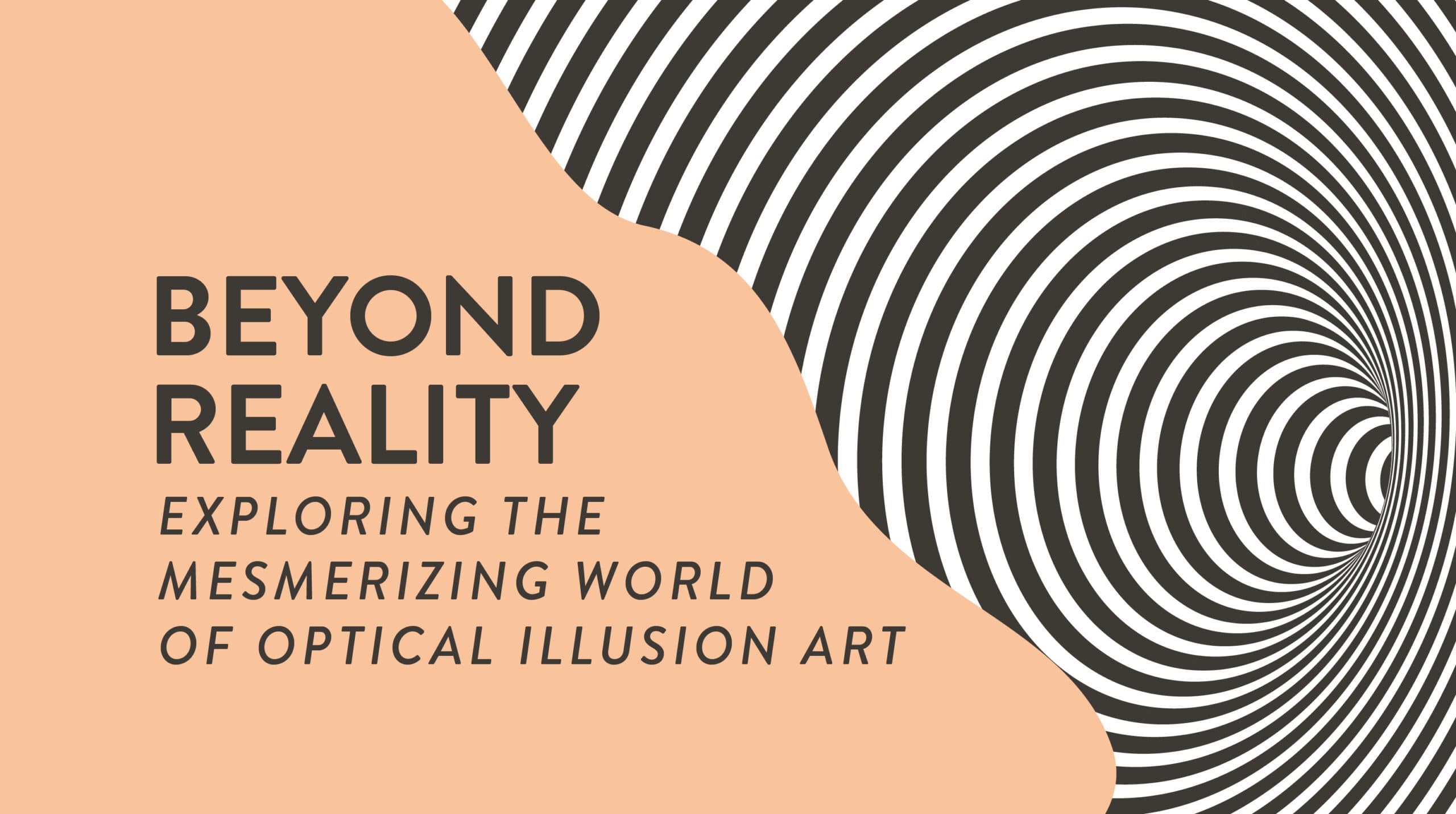
Take a look at the photo above – what do you see? Some see the head of an elephant (hint: it’s looking left). Others see a bull with its chin tilted toward the sky. The 900-year-old optical illusion, originating in India, is considered to be one of the oldest of its kind.
Op art, short for optical illusion art, has boggled the minds of many throughout history. How can these illusions trick our brain so easily? Today, we know that op art can span a variety of media and has the power to cause mass controversy. So, let’s rewind this intentionally-confusing art style and uncover its history, the science behind it, and the powerful techniques used to trick your brain!
The History of Optical Illusion Art
Some might consider optical illusions to be a modern form of art, however, optical illusions can be traced as far back as the time of Aristotle in 300 BC. “His observations include illusions such as pareidolia (people seeing faces in meaningless visual patterns), afterimages (a visual image that outlives the exposure) and motion aftereffects (waterfall illusion),” explains HT School.
Fast forward to the mid-1960s and the international Op art movement exploded in popularity, with artists experimenting with new techniques and ways of creating illusions. This did not come without its critics, however. National Galleries Scotland writes that “Many art critics were opposed to Op Art, dismissing it as commercial, ‘retinal titillations.’” Still, the style has remained popular throughout the 2000s with the rise of digital media and computers.
The Science Behind Optical Illusions

Do you ever struggle to unsee something once you’ve noticed “the trick?” Optical illusions are no different. Take the image above, for example. You might notice a rabbit one second and a duck the next. “Once the prior knowledge is available, our brain quickly accesses it and puts it together with the visual cues that you have gotten from actually looking at the illusion,” explains How Stuff Works.

According to a study done by researchers in Africa, we might be able to attribute these misfires of our brain to culture. Researchers showed the illusion above, depicting two lines of seemingly different lengths, to two thousand people from fifteen different cultural groups. The interesting outcome of this study reveals that depending on your cultural background, you might be more susceptible to falling for these types of illusions. Those with a western cultural background perceived line B to be up to 20 percent longer than line A, whereas African tribes identified them as the same length right away.
“In contrast to most Western societies, the bushmen, Suku, and Bete lived in worlds with very few straight lines. Their houses, often made of thatch, were either rounded or devoid of the hard lines that dominate Western interiors, and they spent most of their time gazing at natural scenes of grassland, trees, and water that similarly lacked geometric angles,” explains writer Adam Alter.
Techniques Used in Creating Optical Illusion Art
There are many different techniques artists use to mislead the viewer. Interweaving the line between reality and illusion can require some serious skill and is often harder than it looks. Let’s explore three of the most popular techniques the trailblazers of Op art used in their prime.
- Depth
Although depth is important to consider for most 2D artwork, it’s especially true when designing an optical illusion. Considering the size, detail, contrast, or value of an optical illusion all have an impact on making a 2D work look 3D. An iconic example of depth manipulation is used in the “trompe-l’œil” technique, where objects are painted in a way that they seem to leap off the canvas.
- Movement
Art history publisher The Collector explains that “Movement has been a key feature of Optical Art since the 1960s, with various artists exploring how to induce motion on a flat surface through dynamic arrangements of shape and color.” British artist Bridget Riley is famous for the use of movement in her works. Riley utilizes various techniques to create the illusion of movement in her works, such as the use of repeating patterns, alternating colors, and strategic placement of lines and shapes.
- Color
Color plays an important role in optical illusions, as it can influence perception and create mind-bending visual effects. Artists such as Victor Vasarely harness the power of color to evoke different emotions and alter the viewer’s perception of space and form.
Different Types of Optical Illusions in Art
In today’s world, you can find many types of optical illusions throughout various mediums. From GIFs to viral videos, illusions have the ability to divide the Internet in two. According to BigThink, there are three main types of optical illusions: literal, physiological, and cognitive.
Literal illusions can be seen in two different ways, such as the duck and rabbit image. Physiological illusions use sensory overload to trick our brains into seeing movement and depth that aren’t actually there. Cognitive illusions trick both our eyes and brain with impossible shapes and logic, such as Oscar Reutersvärd’s “Penrose Triangle.”
Notable Artists and Their Impact on Optical Illusion Art
There have been many famous optical illusion artists throughout history that enjoy the challenge of deceiving others. From the father of op art to a modernist painter, let’s look at the impact these creatives have made in their mediums.
- Victor Vasarely
Victor Vasarely, considered by many to be the father of Op art, played an exponential role in pushing the style forward, most notably in the 1960s. “His works are presently held in the collections of the Albright-Knox Art Gallery in Buffalo, the Art Institute of Chicago, the Tate Gallery in London, and the Peggy Guggenheim Collection in Venice,” writes ArtNet. Vasarely’s works were often colorful, featuring circles, squares, and even abstract shapes of different sizes.
- Bridget Riley
English painter Bridget Riley, who currently resides in London, is famous for not only her Op art pieces involving movement, but was the first woman to receive the painting prize at the Venice Biennale in 1968. Riley’s most famous piece, “Movement in Squares,” cemented her as an abstract artist for creating a powerful piece out of simple squares.
- Oleg Shupliak
Contemporary Ukrainian artist Oleg Shupliak is known for integrating hidden imagery and double meanings within his artworks. Shupliak’s double portrait of Vincent van Gogh is a striking painting that perfectly encapsulates his Op art style.
How to Create Your Own Optical Illusion Art
Whether you’re looking for an illusion art tutorial or just a deeper dive into the style, we’ve got you covered on what to consider when getting started with your own Op art.
- Choose your medium
Are you looking to create anamorphic art in a physical space? Or perhaps you’re looking to save your wallet and stick to using digital tools. Wherever your interests lie, it’s important to define the medium in which you’d like to work. Once you’ve finalized your medium, do some research into what others have done before you, and let that guide your experimentation. “You can make beautiful art with any tools, so you simply need to find a medium that supports your best work. No medium is too simple or too silly if it works for you,” writes illustrator Nicole Cicak.
- Choose your technique
Will you choose to implement depth, movement, color, or something else into your op art? Optical illusions are planned with specific techniques in mind used to trick the viewer. Understanding why these techniques work is an essential step on your journey to creating a successful op art piece.
- Practice, practice, practice
It’s important to keep your expectations in check as you begin creating your first optical illusion. Perhaps you’ll need to adjust your linework, increase a piece’s depth, or even switch illusions entirely. Many professional artists know that it all comes down to practicing your craft and sticking with it. So, what are you waiting for? Start creating!
The Role of Optical Illusion Art in Modern Media and Technology
Modern media and technology has allowed artists to push the envelope of what is possible. From digital programs like Adobe Photoshop and Illustrator to augmented reality experiences, op art is as accessible as ever to artists young and old. In the age of the Internet, these types of illusions can spread quickly and even inspire the next generation of op art artists.
Ready to create your own op art?
Whether you’re interested in learning more about Op art or are ready to embark on a new creative journey, advancing your education in art and design is a great way to become a lifelong learner. Consider earning your BFA on-campus or online at Rocky Mountain College of Art + Design today.

